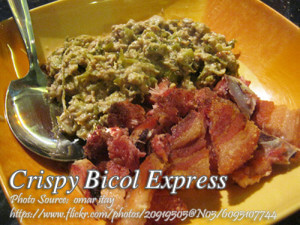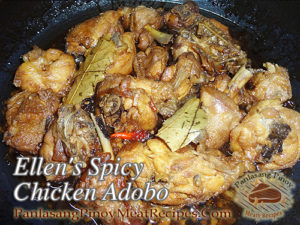Beef Bicol express version uses beef instead of the usual pork in cooking this dish. Compared to pork, beef is more healthy and if you abstain from pork, then I think this is the time you will have chance of eating Bicol express. The reason why it is called Bicol express is because it is a very spicy dish and your mouth will burn and smoke like a choo choo train, just figuratively speaking.
You can also use other chili peppers if siling labuyo is hard to find. With regards to the consistency, some people wants a very thick sauce while other like a saucy dish. You can adjust the water when cooking this dish according to your preference.
Beef Bicol Express: A Family Favorite with a Fiery Twist
One bite of this dish always brings me back to the tiny kitchen of our old family home in Naga, where my Lola Nelya would cook with the windows wide open because the chilies were so pungent, they made everyone tear up—even the neighbors. But instead of the traditional pork, we’re doing a twist on her classic: Beef Bicol Express.
My cousin Edgar, who swore off pork a few years ago, always felt left out during our family get-togethers, especially when this spicy coconut stew was the star of the table. So, one summer, my Tita Lorie gave the old recipe a little makeover. She swapped the pork for beef, and to our surprise, it turned out even richer and more flavorful than the original.
A Healthier Twist on a Spicy Classic
Many Filipinos associate Bicol Express with fiery heat and pork belly cooked until tender in coconut milk. But what most don’t realize is that this dish is incredibly versatile. Using beef instead not only cuts down on the fat, but it also gives the dish a more robust flavor. Plus, for people who avoid pork due to dietary or religious reasons, this version finally gives them a seat at the table.
The name “Bicol Express” actually comes from a train that used to run from Manila to the Bicol region, known for its love of spicy food. It was said that the dish was named by Cely Kalaw, a Laguna-based restaurateur, who introduced the spicy stew to her customers and called it Bicol Express as a nod to its origin and its kick—you know, like a train roaring through your mouth.
How to Cook Beef Bicol Express Like a Pro
This version of beef Bicol express is beginner-friendly, even if you’ve never handled chilies before. Start by browning your beef in a bit of oil. This step is important—it builds flavor right from the start and helps seal in the juices. Once the meat is lightly browned, add a splash of water to soften it a bit. My Uncle Boy always said to let it boil until the beef “relaxes” and soaks up the base flavors.
Then come the aromatics: ginger for warmth, black pepper for depth, and tomatoes for a gentle acidity that balances the richness of the coconut milk. And of course, the siling labuyo. Don’t be scared of these fiery little devils—if you can’t find them, long green chilies or even red Thai chilies work fine. The point is to get that heat that makes the dish unforgettable.
Let everything simmer until the liquid reduces. This slow cooking breaks down the beef fibers, making the meat tender and infusing it with all the spicy, savory flavors.
Add the onions and bay leaves, then pour in the coconut milk and patis (fish sauce). Don’t rush this part. Simmering for a good 30 minutes makes the beef tender and the sauce rich and slightly sweet. You’ll notice the oil from the coconut starting to float on top—that’s a sign it’s nearly done.
Finish with bell peppers for crunch and spring onions for freshness. Some like their sauce thick, almost dry, while others (like my Ate Mila) prefer it saucy enough to soak into the rice. You can adjust the water depending on how you like it.
Tips and Tricks for the Perfect Spicy Stew
Here’s a trick I learned from my neighbor in Camarines Sur: when using beef, especially lean cuts, don’t go too high on the heat. Low and slow is the way to go. High heat can toughen the beef, while gentle simmering helps make it melt-in-your-mouth tender.
Another helpful tip? Let the dish sit for 15–20 minutes before serving. It sounds simple, but it actually allows the flavors to settle and deepen. It’s why this version of Bicol Express with beef tastes even better the next day—if you have any leftovers, that is!
Why You’ll Love This Beef Bicol Express Recipe
What I love most about this dish is how it brings people together. It doesn’t matter if you’re from Luzon, Visayas, or Mindanao—when this stew is on the table, you know it’s going to be a good meal. The heat of the chilies, the richness of the coconut milk, and the tenderness of the beef combine to make a dish that’s both comforting and exciting.
Whether you’re cutting back on pork, exploring new Filipino recipes, or just craving something with a kick, this beef Bicol express is a must-try. And if you ask me, the best part is scooping the sauce onto hot steamed rice and letting the flavors speak for themselves.
Ready to give it a go? Make sure to have a cold glass of water nearby—this train doesn’t stop.
How to Cook Beef Bicol Express
Ingredients
- 1 kilo beef strips
- 2 cups coconut milk
- 3 Tbsp. corn oil
- 2 pcs red onion chopped
- 2 pcs large tomatoes chopped
- 1 inch ginger slice into strips
- 4 pcs siling labuyo bird's eye chilis, chopped
- 2 pcs bay leaves
- 1 Tbsp. patis or fish sauce
- 1 tsp. ground black pepper
- 1 pc sweet pepper sliced
- 1 Tbsp. spring onions chopped
Instructions
How to cook Beef Bicol Express:
- In a medium size wok, heat oil and saute the beef until slightly brown.
- Pour 1/2 cup of water and let it boil.
- Stir then add the ginger, black pepper, tomatoes and siling labuyo.
- Stir for a few minutes then add about 1 cup water. Add more if necessary.
- Cover and simmer the beef until tender and the liquid has evaporated to half.
- Then add onions, bay leaves, patis and coconut milk.
- Mix the ingredients and simmer again for 30 minutes.
- Then add the sweet pepper and spring onions. Simmer for a few seconds then serve.
Notes
Cooking Tips:
Choose the Right Cut of Beef
For the best results, use a cut like beef brisket, chuck, or sirloin that becomes tender with slow cooking. Avoid very lean cuts, as they can turn tough and dry in a simmered dish. Marbling in the meat helps absorb flavors from the spicy coconut sauce.Control the Heat Level
If you're not used to spicy food, start with fewer siling labuyo and adjust as you go. You can substitute with long green chilies or mix in bell peppers to balance the heat. Removing the seeds from the chilies will also help reduce spiciness without losing flavor.Let the Flavors Settle After cooking, allow the dish to rest for 15 to 20 minutes before serving. This resting time lets the coconut milk thicken slightly and the flavors deepen. Beef Bicol express actually tastes better the next day, making it a great make-ahead meal.





